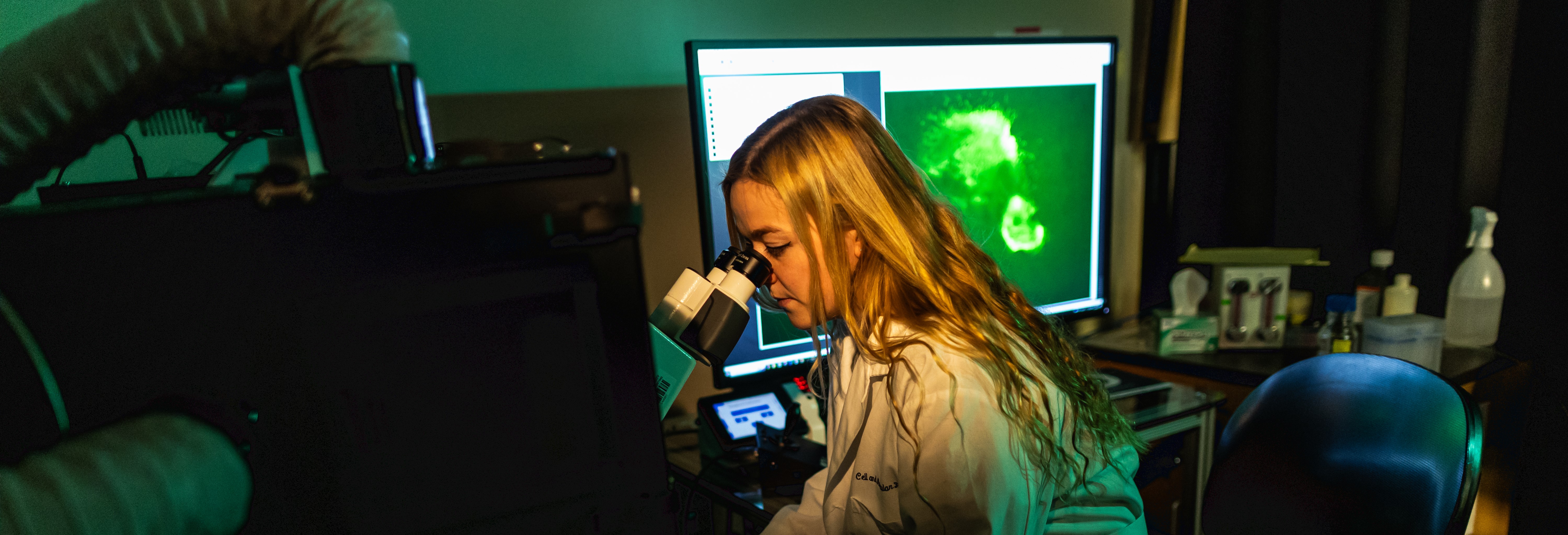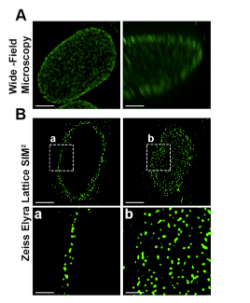
Super Resolution Microscope
Super Resolution Microscope acquired by Health Sciences Campus
The students and researchers in Loyola University Chicago’s graduate Biomedical Sciences programs will soon benefit from having access to some of the most cutting-edge tools in the field of super resolution microscopy. These imaging tools help take our faculty and graduate student research to the next level, literally seeing beyond the limits of light.
With funds won from an S10 Instrumentation Grant from the National Institutes of Health (NIH) to Edward Campbell, PhD, Department of Microbiology and Immunology, Loyola has acquired a Zeiss Lattice SIM 5 Super Resolution Microscope system. This system combines multiple new features to increase the speed, processing, and resolution of images, compared to other traditional light microscopes.
Super resolution microscopy enables researchers to see finer details of molecules and proteins with remarkable clarity. This system's superior temporal resolution also offers the ability to follow these structures through time without sacrificing the increase in spatial resolution. The system can capture images at up to 255 frames per second, allowing researchers to view sequences of events previously viewed as a blur or that even might be missed entirely.
WHAT IS SUPER RESOLUTION MICROSCOPY?
In microscopy, resolution is key. It refers to the microscope's ability to distinguish minute details within a specimen or sample. With traditional approaches, the laws of physics limit the resolution of light microscopes to approximately ~250 nm (around 1/300th the width of a typical human hair!). Any objects closer than this 250 nm limit look like a single point.
The term “super resolution” is used when the spatial resolution is below the standard limits of optical resolution. The Lattice SIM 5 uses an approach called Structured Illumination Microscopy (SIM) to achieve resolutions down to 60 nm, or approximately 4X that of standard light microscopes. Super resolution microscopy opens a window into the intricate world of molecules and cells, offering greater clarity and detail.

“This microscope will allow us to resolve structures that had been unresolvable due to the pesky physics of conventional light microscopy. Being able to resolve structures, such as individual nuclear pore complexes, and monitor them over time, in living cells, will be a real game changer for research on this campus.” Dr. Edward Campbell
Benefits for Graduate Programs in Biomedical Sciences
The addition of super resolution fluorescence microscopy significantly enhances our imaging core facility abilities and offers tremendous potential for advancing research and education.
All graduate Biomedical Sciences programs will have access to this super resolution microscopy technology at Loyola University Chicago, including all of our PhD and Masters students studying at the Health Sciences Campus.
Enhanced Research Capabilities
Light microscopy adds a different dimension to biological research, as highlighted recently in Loyola magazine, allowing researchers to see when and where proteins are interacting within the cell. The addition of new super resolution microscopy technology presents a stimulating opportunity for Loyola’s graduate students to elevate their thesis and dissertation research. By providing views of cellular structures and processes, super resolution microscopy equips graduate students with tools to explore complex biological phenomena across a variety of disciplines.
The team of researchers behind the grant came from across our basic science departments, demonstrating its broad appeal. Graduate students engaged in Cellular Molecular Oncology, Microbiology & Immunology, Neuroscience, Infectious Disease & Immunology, Molecular Pharmacology & Therapeutics, Integrative Cell Biology, Cell & Molecular Physiology, and Biochemistry & Molecular Biology can leverage super resolution microscopy to deepen their understanding of cellular dynamics. By observing cellular interactions and processes at a higher resolution, students gain insights into the intricacies of biological systems, paving the way for innovative research projects and hypotheses.
Expanded Understanding of Cellular Dynamics
Graduate students on the Health Sciences Campus at Loyola University Chicago do a lot of work with cell cultures. One of the key benefits of the Lattice SIM 5 system is that it can be used for live cell imaging. The application of a large field of view, superior spatial and temporal resolution, low laser dosage on cells, and the ability to capture images from two channels simultaneously makes the Lattice SIM 5 system a great tool for live cell imaging.
Work from Melissa Quintanilla, PhD, a recent graduate who worked in the Beach lab (Department of Cell & Molecular Physiology), illustrates the power of quantitative super resolution microscopy in live imaging. In her article, published in the Journal of Cell Biology, she used super resolution microscopy to investigate the assembly mechanisms of myosin II motor proteins, showing that self-association of filaments plays an important role in building new filaments.
Skill Development
Incorporating super resolution microscopy into Loyola’s health sciences graduate programs gives students hands-on experience in advanced imaging techniques. By mastering these tools, students develop essential skills for conducting biological research and better preparing them for careers in academia, industry, research and healthcare.
Harnessing the power of Super Resolution Microscopy at Loyola University Chicago
Through the advanced capabilities of super resolution microscopy, Loyola researchers are unraveling molecular mysteries. Whether it's visualizing specific features of microbes or enhancing 3D structures at small scales, these techniques pave the way for groundbreaking discoveries and advancements in biomedical research.
If you're interested in exploring Loyola University Chicago’s Biomedical Sciences programs or conducting research using super resolution microscopy, we invite you to learn more. Take the next step in your biomedical research career. Discover the opportunities available for academic excellence and scientific advancement at Loyola University Chicago.
Super Resolution Microscope acquired by Health Sciences Campus
The students and researchers in Loyola University Chicago’s graduate Biomedical Sciences programs will soon benefit from having access to some of the most cutting-edge tools in the field of super resolution microscopy. These imaging tools help take our faculty and graduate student research to the next level, literally seeing beyond the limits of light.
With funds won from an S10 Instrumentation Grant from the National Institutes of Health (NIH) to Edward Campbell, PhD, Department of Microbiology and Immunology, Loyola has acquired a Zeiss Lattice SIM 5 Super Resolution Microscope system. This system combines multiple new features to increase the speed, processing, and resolution of images, compared to other traditional light microscopes.
Super resolution microscopy enables researchers to see finer details of molecules and proteins with remarkable clarity. This system's superior temporal resolution also offers the ability to follow these structures through time without sacrificing the increase in spatial resolution. The system can capture images at up to 255 frames per second, allowing researchers to view sequences of events previously viewed as a blur or that even might be missed entirely.
WHAT IS SUPER RESOLUTION MICROSCOPY?
In microscopy, resolution is key. It refers to the microscope's ability to distinguish minute details within a specimen or sample. With traditional approaches, the laws of physics limit the resolution of light microscopes to approximately ~250 nm (around 1/300th the width of a typical human hair!). Any objects closer than this 250 nm limit look like a single point.
The term “super resolution” is used when the spatial resolution is below the standard limits of optical resolution. The Lattice SIM 5 uses an approach called Structured Illumination Microscopy (SIM) to achieve resolutions down to 60 nm, or approximately 4X that of standard light microscopes. Super resolution microscopy opens a window into the intricate world of molecules and cells, offering greater clarity and detail.

Benefits for Graduate Programs in Biomedical Sciences
The addition of super resolution fluorescence microscopy significantly enhances our imaging core facility abilities and offers tremendous potential for advancing research and education.
All graduate Biomedical Sciences programs will have access to this super resolution microscopy technology at Loyola University Chicago, including all of our PhD and Masters students studying at the Health Sciences Campus.
Enhanced Research Capabilities
Light microscopy adds a different dimension to biological research, as highlighted recently in Loyola magazine, allowing researchers to see when and where proteins are interacting within the cell. The addition of new super resolution microscopy technology presents a stimulating opportunity for Loyola’s graduate students to elevate their thesis and dissertation research. By providing views of cellular structures and processes, super resolution microscopy equips graduate students with tools to explore complex biological phenomena across a variety of disciplines.
The team of researchers behind the grant came from across our basic science departments, demonstrating its broad appeal. Graduate students engaged in Cellular Molecular Oncology, Microbiology & Immunology, Neuroscience, Infectious Disease & Immunology, Molecular Pharmacology & Therapeutics, Integrative Cell Biology, Cell & Molecular Physiology, and Biochemistry & Molecular Biology can leverage super resolution microscopy to deepen their understanding of cellular dynamics. By observing cellular interactions and processes at a higher resolution, students gain insights into the intricacies of biological systems, paving the way for innovative research projects and hypotheses.
Expanded Understanding of Cellular Dynamics
Graduate students on the Health Sciences Campus at Loyola University Chicago do a lot of work with cell cultures. One of the key benefits of the Lattice SIM 5 system is that it can be used for live cell imaging. The application of a large field of view, superior spatial and temporal resolution, low laser dosage on cells, and the ability to capture images from two channels simultaneously makes the Lattice SIM 5 system a great tool for live cell imaging.
Work from Melissa Quintanilla, PhD, a recent graduate who worked in the Beach lab (Department of Cell & Molecular Physiology), illustrates the power of quantitative super resolution microscopy in live imaging. In her article, published in the Journal of Cell Biology, she used super resolution microscopy to investigate the assembly mechanisms of myosin II motor proteins, showing that self-association of filaments plays an important role in building new filaments.
Skill Development
Incorporating super resolution microscopy into Loyola’s health sciences graduate programs gives students hands-on experience in advanced imaging techniques. By mastering these tools, students develop essential skills for conducting biological research and better preparing them for careers in academia, industry, research and healthcare.
Harnessing the power of Super Resolution Microscopy at Loyola University Chicago
Through the advanced capabilities of super resolution microscopy, Loyola researchers are unraveling molecular mysteries. Whether it's visualizing specific features of microbes or enhancing 3D structures at small scales, these techniques pave the way for groundbreaking discoveries and advancements in biomedical research.
If you're interested in exploring Loyola University Chicago’s Biomedical Sciences programs or conducting research using super resolution microscopy, we invite you to learn more. Take the next step in your biomedical research career. Discover the opportunities available for academic excellence and scientific advancement at Loyola University Chicago.
